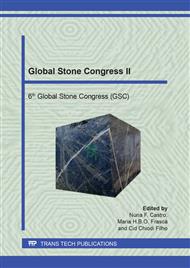[1]
L. Mancini and S. Sala, Social impact assessment in the mining sector: Review and comparison of indicators frameworks,, Resources Policy, vol. 57, p.98–111, Aug. (2018).
DOI: 10.1016/j.resourpol.2018.02.002
Google Scholar
[2]
A. Mateus and L. Martins, Challenges and opportunities for a successful mining industry in the future.,, BGM, vol. 130, no. 1, p.99–121, Mar. (2019).
DOI: 10.21701/bolgeomin.130.1.007
Google Scholar
[3]
V. Steinbach and F.-W. Wellmer, Consumption and Use of Non-Renewable Mineral and Energy Raw Materials from an Economic Geology Point of View,, Sustainability, vol. 2, no. 5, p.1408–1430, (2010).
DOI: 10.3390/su2051408
Google Scholar
[4]
J. E. Tilton et al., Public policy and future mineral supplies,, Resources Policy, vol. 57, p.55–60, Aug. (2018).
Google Scholar
[5]
P. A. J. Lusty and A. G. Gunn, Challenges to global mineral resource security and options for future supply,, Geological Society, London, Special Publications, vol. 393, no. 1, p.265–276, (2015).
DOI: 10.1144/sp393.13
Google Scholar
[6]
M. L. C. M. Henckens, Managing raw materials scarcity : safeguarding the availability of geologically scarce mineral resources,, Utrecht University, (2016).
Google Scholar
[7]
P. Anciaux, Sustainable Development Indicators for the EU Non-Energy Extractive Industry,, in A Review on Indicators of Sustainability: for the mineral extraction industries, R. Villas Boas, D. Shields, S. Solar, P. Anciaux, and G. Önal, Eds. Rio de Janeiro: CETEM/CNPq/CYTED, 2005, p.63–72.
Google Scholar
[8]
Wellmer F.-W. and Becker-Platen J., Sustainable development and the exploitation of mineral and energy resources: a review,, International Journal of Earth Sciences, vol. 91, no. 5, p.723–745, (2002).
Google Scholar
[9]
P. Christmann, N. Arvanitidis, L. Martins, G. Recoché, and S. Solar, Towards the Sustainable Use of Mineral Resources: A European Geological Surveys Perspective,, Minerals & Energy - Raw Materials Report, vol. 22, no. 3–4, p.88–104, Dec. (2007).
DOI: 10.1080/14041040701405662
Google Scholar
[10]
C.E. Wrighton, E.J. Bee, and J.M. Mankelow, The development and implementation of mineral safeguarding policies at national and local levels in the United Kingdom,, Resources Policy, vol. 41, p.160–170, Sep. (2014).
DOI: 10.1016/j.resourpol.2014.05.006
Google Scholar
[11]
M. Regueiro, L. Martins, and S. Arvidsson, Minerals in Europe: the risks of outsourcing,, Brussels, EuroGeoSurveys Opinion 9, 27 March 2000, (2000).
Google Scholar
[12]
P. Christmann, Towards a thematic strategy on the sustainable use of natural resources - Working Group 1 – "Supply of Resources",, The European Union 6th Environmental Action Programme, Brussels, (2004).
Google Scholar
[13]
European Commission, Communication from the Commission to the European Parliament and the Council: The Raw Materials Initiative - Meeting our critical needs for growth and jobs in Europe. 2008, p.15.
Google Scholar
[14]
European Commission, Communication from the Commission to the European Parliament, the Council, the European Economic and Social Committee and the Commitee of the Regions: Making raw materials available for Europe's future wellbeing - Proposal for a European Innovation Partnership on Raw Materials. (2012).
DOI: 10.54648/eerr1996017
Google Scholar
[15]
MINATURA2020, MINATURA2020 Project,, 2015. [Online]. Available: https://minatura2020.eu.
Google Scholar
[16]
Minland, The MinLand Project,, 2018. [Online]. Available: https://minland.eu/.
Google Scholar
[17]
J. Carvalho et al., Safeguarding mineral resources in Europe: existing practice and possibilities,, EU Commission - Minland Project, Brussels, Deliverable 2.3, (2019).
Google Scholar
[18]
C. Roumpos and E. Papacosta, Strategic mine planning of surface mining projects incorporating sustainability concepts,, presented at the 6th International Conference on Sustainable Development in the Minerals Industry, Milos island, Greece, (2013).
Google Scholar
[19]
J. Sheng and L. Li-zhong, Discussion on theory and methods of land-use planning in mining area,, Procedia Earth and Planetary Science, vol. 1, no. 1, p.956–962, Sep. (2009).
DOI: 10.1016/j.proeps.2009.09.148
Google Scholar
[20]
N. Careddu and G. Siotto, Promoting ecological sustainable planning for natural stone quarrying. The case of the Orosei Marble Producing Area in Eastern Sardinia,, Resources Policy, vol. 36, no. 4, p.304–314, Dec. (2011).
DOI: 10.1016/j.resourpol.2011.07.002
Google Scholar
[21]
N. Careddu, G. Siotto, R. Siotto, and C. Tilocca, From landfill to water, land and life: The creation of the Centre for stone materials aimed at secondary processing,, Resources Policy, vol. 38, no. 3, p.258–265, Sep. (2013).
DOI: 10.1016/j.resourpol.2013.05.001
Google Scholar
[22]
K. Wrana, L. Trząski, M. Głogowska, M. Lebek, W. Chmielewski, and W. Szendera, Model of Local Sustainable Development in the Areas of Co-Occurrence Natura 2000 Sites and Non Energy Mining Industry (NEEI),, Journal of Sustainable Mining, vol. 13, no. 3, p.19–25, (2014).
DOI: 10.7424/jsm140304
Google Scholar
[23]
E. Marnika, E. Christodoulou, and A. Xenidis, Sustainable development indicators for mining sites in protected areas: tool development, ranking and scoring of potential environmental impacts and assessment of management scenarios,, Journal of Cleaner Production, vol. 101, p.59–70, Aug. (2015).
DOI: 10.1016/j.jclepro.2015.03.098
Google Scholar
[24]
G. Hernandez-Duran, J. C. Arranz-González, and R. Vega-Panizo, El análisis del potencial geológico de rocas industriales en proyectos de planificación territorial: una revisión,, Boletín Geológico y Minero, vol. 125, no. 4, p.475–492, (2014).
DOI: 10.21701/bolgeomin.127.4.001
Google Scholar
[25]
R. C. L. Wilson, R. N. Hiscott, M. G. Willis, and F. M. Gradstein, The Lusitanian Basin of west-central Portugal: Mesozoic and Tertiary tectonic, stratigraphic, and subsidence history,, in Extensional tectonics and stratigraphy of the North Atlantic margins, A. J. Tankard and H. R. Balkwill, Eds. 1989, p.341–361.
DOI: 10.1306/m46497c22
Google Scholar
[26]
A. C. Azerêdo, Geometry and facies dynamics of Middle Jurassic carbonate ramp sandbodies, West-Central Portugal,, in Geological Society Special Publication 149, V. P. Wright and T. P. Burchete, Eds. 1998, p.281–314.
DOI: 10.1144/gsl.sp.1999.149.01.14
Google Scholar
[27]
J.M.F. Carvalho, Rochas Ornamentais do Maciço Calcário Estremenho: Breve Caraterização dos Recursos, dos Centros de Produção e Delimitação Preliminar de Áreas Potenciais.,, Boletim de Minas, vol. 47, no. 1, p.5–26, (2012).
Google Scholar
[28]
J.M.F. Carvalho, J. Sampaio, S. Machado, C. Midões, C. Prazeres, and R. Sardinha, Caraterização e valorização da área de intervenção específica de Cabeça Veada,, LNEG e CEVALOR, Lisboa, Relatório interno do Cluster da Pedra Natural - COMPETE/QREN, (2014).
Google Scholar


